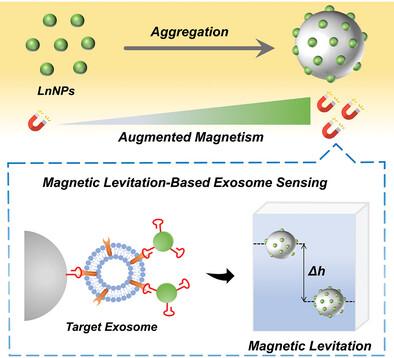当前位置:
X-MOL 学术
›
Adv. Mater.
›
论文详情
Our official English website, www.x-mol.net, welcomes your feedback! (Note: you will need to create a separate account there.)
Aggregation-Augmented Magnetism of Lanthanide-Doped Nanoparticles and Enabling Magnetic Levitation-Based Exosome Sensing
Advanced Materials ( IF 27.4 ) Pub Date : 2024-06-27 , DOI: 10.1002/adma.202407013 Yuanyuan Dong 1 , Wei Ren 1 , Yuanyuan Sun 2 , Xinrui Duan 1 , Chenghui Liu 1
Advanced Materials ( IF 27.4 ) Pub Date : 2024-06-27 , DOI: 10.1002/adma.202407013 Yuanyuan Dong 1 , Wei Ren 1 , Yuanyuan Sun 2 , Xinrui Duan 1 , Chenghui Liu 1
Affiliation

|
Due to the presence of unpaired electron orbitals in most lanthanide ions, lanthanide-doped nanoparticles (LnNPs) exhibit paramagnetism. However, as to biosensing applications, the magnetism of LnNPs is so weak that can hardly be employed in target separation. Herein, it is discovered that the magnetism of the LnNPs is highly associated with their concentration in a confined space, enabling aggregation-augmented magnetism to make them susceptive to a conventional magnet. Accordingly, a magnetic levitation (Maglev) sensing system is designed, in which the target exosomes can specifically introduce paramagnetic LnNPs to the microbeads’ surface, allowing aggregation-augmented magnetism and further leverage the microbeads’ levitation height in the Maglev device to indicate the target exosomes' content. It is demonstrated that this Maglev system can precisely distinguish healthy people's blood samples from those of breast cancer patients. This is the first work to report that LnNPs hold great promise in magnetic separation-based biological sample sorting, and the LnNP-permitted Maglev sensing system is proven to be promising for establishing a new generation of biosensing devices.
中文翻译:

稀土掺杂纳米粒子的聚集增强磁性和实现基于磁悬浮的外泌体传感
由于大多数稀土离子中存在不成对的电子轨道,稀土掺杂纳米粒子(LnNP)表现出顺磁性。然而,对于生物传感应用,LnNPs的磁性很弱,很难用于目标分离。在此,我们发现LnNPs的磁性与其在有限空间中的浓度高度相关,使得聚集增强磁性使它们对传统磁体敏感。因此,设计了磁悬浮(Maglev)传感系统,其中目标外泌体可以特异性地将顺磁性LnNP引入微珠表面,从而实现聚集增强磁性,并进一步利用磁悬浮装置中微珠的悬浮高度来指示目标外泌体的含量。事实证明,该磁悬浮系统可以精确地区分健康人的血液样本与乳腺癌患者的血液样本。这是第一篇报道 LnNP 在基于磁分离的生物样品分选方面具有巨大前景的工作,并且 LnNP 许可的磁悬浮传感系统被证明有望用于建立新一代生物传感设备。
更新日期:2024-07-02
中文翻译:

稀土掺杂纳米粒子的聚集增强磁性和实现基于磁悬浮的外泌体传感
由于大多数稀土离子中存在不成对的电子轨道,稀土掺杂纳米粒子(LnNP)表现出顺磁性。然而,对于生物传感应用,LnNPs的磁性很弱,很难用于目标分离。在此,我们发现LnNPs的磁性与其在有限空间中的浓度高度相关,使得聚集增强磁性使它们对传统磁体敏感。因此,设计了磁悬浮(Maglev)传感系统,其中目标外泌体可以特异性地将顺磁性LnNP引入微珠表面,从而实现聚集增强磁性,并进一步利用磁悬浮装置中微珠的悬浮高度来指示目标外泌体的含量。事实证明,该磁悬浮系统可以精确地区分健康人的血液样本与乳腺癌患者的血液样本。这是第一篇报道 LnNP 在基于磁分离的生物样品分选方面具有巨大前景的工作,并且 LnNP 许可的磁悬浮传感系统被证明有望用于建立新一代生物传感设备。











































 京公网安备 11010802027423号
京公网安备 11010802027423号